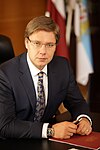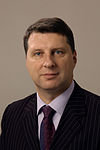2011 Latvian parliamentary election
| |||||||||||||||||||||||||||||||||||||||||||||||||||||||||||||||||||||||||||||||||||||||||
All 100 seats in the Saeima 51 seats needed for a majority | |||||||||||||||||||||||||||||||||||||||||||||||||||||||||||||||||||||||||||||||||||||||||
|---|---|---|---|---|---|---|---|---|---|---|---|---|---|---|---|---|---|---|---|---|---|---|---|---|---|---|---|---|---|---|---|---|---|---|---|---|---|---|---|---|---|---|---|---|---|---|---|---|---|---|---|---|---|---|---|---|---|---|---|---|---|---|---|---|---|---|---|---|---|---|---|---|---|---|---|---|---|---|---|---|---|---|---|---|---|---|---|---|---|
| |||||||||||||||||||||||||||||||||||||||||||||||||||||||||||||||||||||||||||||||||||||||||
| |||||||||||||||||||||||||||||||||||||||||||||||||||||||||||||||||||||||||||||||||||||||||
An early parliamentary election was held in Latvia on 17 September 2011,[1] following the country's first parliamentary dissolution referendum held on 23 July 2011. The last parliamentary election was held only in October 2010.
The election resulted in Harmony Centre winning the most seats, up two to 31. This was the first time a pro-Russian party had won the most seats in a Latvian election. Unity, previously the largest party, fell to third, with 20 seats, behind the newly formed Zatlers' Reform Party, led by ex-President Valdis Zatlers, who had triggered the dissolution referendum in May. The right-wing National Alliance gained six seats to 14. Both the Union of Greens and Farmers and Latvia's First Party/Latvian Way lost heavily, with the latter falling out of the Saeima altogether.
Zatlers and incumbent Prime Minister Valdis Dombrovskis soon agreed to form a coalition. Needing nine further seats to give them a majority allowed three possible coalitions – with Harmony Centre, the National Alliance, or the Union of Greens and Farmers. The Greens and Farmers were quickly ruled out by Zatlers, who judged it to be an "oligarch's party". After initial talks with the National Alliance, the two briefly discussed a grand coalition with Harmony Centre. However, Zatlers and Unity returned to the National Alliance, and the three signed a coalition agreement on 11 October, with Dombrovskis as Prime Minister. The new government was confirmed by the Saeima on 25 October. A few days before the government formation, six MPs split from Zatlers' Reform Party; they still supported the new government, however.[2]
Background
Prior to the election, a number of changes in Latvia's party system occurred:
- The Social Democratic Party "Harmony" absorbed Daugavpils City Party.[3]
- The People's Party dissolved itself amid high debts and quickly sinking popularity.[4]
- For Fatherland and Freedom/LNNK and All For Latvia! turned their election alliance National Alliance into a joint party.[5]
- The New Era Party, Civic Union and Society for Other Politics turned their election alliance Unity into a joint party.[6]
- Former president Valdis Zatlers (responsible for the referendum) founded Zatlers' Reform Party, which is enjoying great popularity in election polls. Zatlers' stated goal is to remove the influence of oligarchs on Latvian politics; with the dissolution of the People's Party, the parties Zatlers considers to represent oligarchs are the Union of Greens and Farmers and Latvia's First Party/Latvian Way.[5]
Results
The Harmony Centre party, led by Nils Ušakovs, finished with about 29% of the vote, followed by Zatlers' Reform Party with 21% and the Unity party with 18%.[7] The National Alliance and the Union of Greens and Farmers were the only other parties to enter Parliament, with fourteen and twelve percent of the vote, respectively.[7] Harmony Centre's victory was the first for a pro-Russian party since Latvia's independence; the party has ties to United Russia.[8]
Template:Latvian parliamentary election, 2011
Government formation
Despite winning the most seats, Harmony Centre, was unable to come to an agreement to form a coalition that would hold a majority in parliament immediately after the election.[7] Usakovs entered talks with Zatlers Reform Party and Unity following the election with the aim of forming a coalition,[8] though political analysts said that a potential stumbling block in the talks could be the opposition of other parties to Harmony Centre's connection to Latvia's Russian-speaking population.[7] The most likely potential coalition was predicted to be Zatlers' Reform Party, Unity and National Alliance.[9] Valdis Dombrovskis was believed to remain Prime Minister, despite his party finishing behind the Reform Party.
Zatlers stated on 1 October 2011 that he preferred a coalition with Dombrovskis as PM and including Harmony Centre.[10] However, on 10 October 2011, reports indicated a coalition with the National Alliance was all but certain.[11]Eventually a Unity-Reform Party-National Alliance coalition was formed.
References
- ^ "Latvians sack parliament, head to early elections". EurActiv. 2011-07-25. Retrieved 2011-10-07.
- ^ Eglitis, Aaron (2011-10-25). "Latvian Parliament Confirms New Government Led By Dombrovskis". Businessweek. Retrieved 2013-12-24.
- ^ DELFI. "Daugavpils partija iekļaujas 'Saskaņā'; SC veidos divi spēki - DELFI". Delfi.lv. Retrieved 2011-10-07.
- ^ Nolemj likvidēt Tautas partiju Template:Lv icon
- ^ a b "Latvian political parties undergo major upheaval", Baltic Times, 12 July 2011, retrieved 18 July 2011
- ^ Apollo – Ziņas: Izveidota partija «Vienotība». Apollo.lv. Retrieved on 19 September 2011.
- ^ a b c d "Pro-Russia party wins most votes in Latvia election". BBC News Online. 18 September 2011. Archived from the original on 19 September 2011. Retrieved 20 September 2011.
{{cite web}}: Unknown parameter|deadurl=ignored (|url-status=suggested) (help) - ^ a b "Pro-Russia party may take power in Latvia if it can form coalition". The Guardian. 19 September 2011. Archived from the original on 19 September 2011. Retrieved 20 September 2011.
{{cite web}}: Unknown parameter|deadurl=ignored (|url-status=suggested) (help) - ^ Maktlösa vinnare i Lettland. Dagens Nyheter. 2011-09-18.
- ^ Andris Straumanis. "Zatlers wants Dombrovskis as PM in coalition with Unity, Harmony Centre". Latviansonline.com. Retrieved 2011-10-07.
- ^ derStandard.at. "Rechtsregierung mit Ultranationalisten so gut wie sicher - Lettland - derStandard.at › International" (in German). Derstandard.at. Retrieved 2013-12-24.
External links
- Official election results Template:Lv icon
- Vladimir Socor: Latvia Facing Its Toughest Test Since 1991 In Upcoming Elections (Part One), in: jamestown.org, July 27, 2011.
- Vladimir Socor: Realignments In Latvia’s Political Landscape Ahead of Crucial Elections (Part Two), in: jamestown.org, July 28, 2011.
- NSD: European Election Database - Latvia publishes regional level election data; allows for comparisons of election results, 1990–2011





